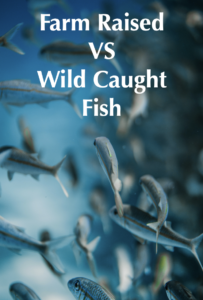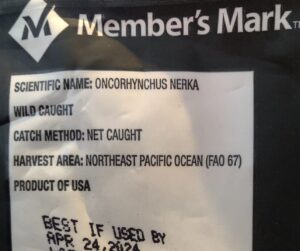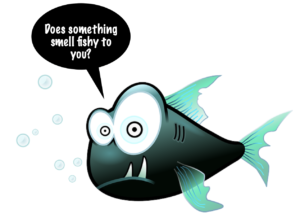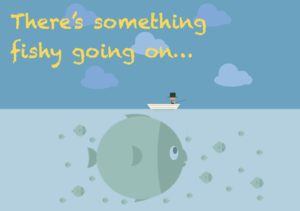 Are you intimidated when it comes to seafood?
Are you intimidated when it comes to seafood?
Maybe you are like my in-laws, who love eating fish, but rarely make it at home because of the intimidation factor. Or maybe you had a bad experience earlier in life that has stayed with you, causing you to think, “I don’t like fish.”
We want to help increase your confidence because good quality seafood provides great health benefits. It is rich in omega-3s, which are important for brain health, metabolism, and keeping inflammation in check. Plus, it is absolutely delicious when prepared in the right ways. We did the Panko Crusted Mustard Salmon in a cooking demo recently and several people said, “I don’t like fish, but I absolutely love this!”
Where can you go to find (and how do you choose) high-quality seafood?
Let’s be honest, for those of us who don’t live on the coast, it can be challenging to find high-quality, fresh seafood…
…many of us aren’t exactly surrounded by fresh-water oceans, lakes, bays and rivers.
We are blessed to have crossed paths with the owners of several seafood shops, both locally in Wichita and during our travels the past several years. They have all been kind enough to share their expertise and robust knowledge and answer our many questions — to help us understand how to select, store, and prepare high-quality seafood.
What are the most important things to consider when buying seafood?
 The first is to understand what you like and know your palate. Explore the flavor and texture of different varieties of seafood. Some people like their fish to be very mild, almost bland, while others like fish that have a more mellow flavor. And then some want their fish to be rich, bold and full of flavor. Fish can be delicate (with small soft flakes), medium (with delicate, but firm, medium flakes) or firm (larger flakes and a meat-like texture).
The first is to understand what you like and know your palate. Explore the flavor and texture of different varieties of seafood. Some people like their fish to be very mild, almost bland, while others like fish that have a more mellow flavor. And then some want their fish to be rich, bold and full of flavor. Fish can be delicate (with small soft flakes), medium (with delicate, but firm, medium flakes) or firm (larger flakes and a meat-like texture).
For example, flounder is a mild, delicate fish. Pink salmon, crab meat, and rainbow trout also have a delicate texture, but have a more moderate flavor. Oysters and mussels have a delicate texture, with a much fuller flavor. Examples of medium-textured fish would include cod, sea bass, lobster and shrimp. Then, firmer fish would include farmed catfish, mahi mahi, swordfish and albacore tuna.
For those that are unsure what they like, a milder fish such as trout or flounder can be a good place to start. They also blend well with other flavors.
It is also important to know where the fish comes from and develop a relationship with the person you buy your seafood from.
What do all the buzzwords mean?
 The labels on the package should say where the fish came from and how it was caught. But it can be confusing to understand the differences between “wild-caught,” “farm-raised,” “sustainable” and other terms used to describe seafood. It is important to recognize there are pros and cons to each.
The labels on the package should say where the fish came from and how it was caught. But it can be confusing to understand the differences between “wild-caught,” “farm-raised,” “sustainable” and other terms used to describe seafood. It is important to recognize there are pros and cons to each.
The best option is to find wild-caught seafood from a region with good sustainability practices (areas like the U.S., Canada, Iceland or New Zealand). It’s kind of like with meat – you want to eat fish that are living in as natural and clean of an environment as possible. Remember, “you are what you eat eats!”
 For farm-raised seafood, you want it to be from a low-density farm, with no color added, no antibiotics, and with fish fed a natural diet in their natural environment. It is crucial to understand that different farms have different practices, and some can be cleaner and have more robust facilities and practices than others. This is where you can rely on the knowledge of a local seafood shop to help you purchase from sources that meet important quality standards.
For farm-raised seafood, you want it to be from a low-density farm, with no color added, no antibiotics, and with fish fed a natural diet in their natural environment. It is crucial to understand that different farms have different practices, and some can be cleaner and have more robust facilities and practices than others. This is where you can rely on the knowledge of a local seafood shop to help you purchase from sources that meet important quality standards.
Some of the owners we spoke to are fans of “ocean raised” seafood. This is a newer method of farming, also called “open ocean fish farming,” where ocean farm structures are used to naturally expand aquaculture growth. Think of it as fish farms that are moved further offshore. There are several advantages to this approach, and challenges that must be overcome. These ocean farms are now being equipped with cameras and sensors and have been impressively providing an excellent environment for raising quality fish.
What should fresh fish smell and feel like?
 Always ask to smell it before you buy it (no one will think this is strange!). Fresh fish should not have a distinct smell at all…and definitely not “fishy!”
Always ask to smell it before you buy it (no one will think this is strange!). Fresh fish should not have a distinct smell at all…and definitely not “fishy!”
For fillets, steaks, or loins, look for bright color and firm flesh, which should be moist (but not slimy). For whole fish, look for clear eyes (except for walleye), bright red gills, firm flesh, and tightly adhered scales. Live shellfish should be lively and heavy, and for shelled fish such as clams and oysters, the shells should be tightly closed, or should close when tapped.
What is the difference between fresh and frozen fish?
Fresh fish will be just that – fresher. There is nothing wrong with frozen fish, especially when it is flash frozen shortly after it is caught. A benefit of buying fresh vs frozen is you know the age of your fish. It’s also important to know the difference between fresh vs previously frozen or “refreshed” fish, so read the small print at your store.
Once fish has been frozen once, it should not be re-frozen. If you are going to freeze your fresh fish, you can ask your fishmonger to wrap your purchase for the freezer. For example, our local seafood shop will wrap your purchase in plastic wrap and freezer paper, and then portion it and label it for the freezer, for no additional charge.
If you are using frozen fish, you can thaw it in the fridge (which will take a few hours). If you forgot to put it in the fridge, you can put the fish (still in its packaging) in a big bowl and cover it with water that’s a little cooler than room temperature. You may need to change the water once or twice to get the fish fully thawed. It is NOT a good idea to thaw it at room temperature or in the microwave, as this can affect the texture or allow bacteria to grow.
How long will fresh fish stay good?
Fresh fish will keep for about 4 days. You should store it in the refrigerator and, if necessary, the local shop owner can provide you with extra wrap and some people suggest changing the wrap every 24 hours to extend its freshness. If it begins to smell “fishy” because you are pushing the 4-day limit, you can give your fish a bath in club soda to help remove the smell.
What about bones?
A good seller should ask if you want the bones removed. Many seafood shops will remove bones, if necessary, at no additional charge. To make it most convenient, consider pre-ordering or provide a little notice if you need something more involved, such as a few dozen oysters shucked.
What fish have high mercury levels and why does that matter?
The fish with the highest mercury levels are shark, swordfish, tilefish and king mackerel. This is because they are larger fish, which have feasted on smaller mercury-containing fish. Mercury is a concern because it can harm the nervous system, including in developing fetuses, infants and young children. Prolonged or excessive consumption of fish with high mercury levels can lead to cognitive and developmental issues, which we all obviously want to avoid.
Zonya’s Take:
Albacore tuna, is recommended not more than once a month, and Light tuna, not more than twice a week. (Yes, this is in regard to fresh or canned, and a lot of low carb dieters out there are dangerously overdoing cans of tuna, so take note!)
What about that “fishy” smell?
 There are a couple of things you can do to prevent or run any unpleasant odor out of your house:
There are a couple of things you can do to prevent or run any unpleasant odor out of your house:
- First, don’t buy fish that smells “fishy.”
- Consider including lemon juice when cooking fish.
- Sacrifice a fresh lemon! Place a chopped lemon (quarter sized pieces, peel and all) down your garbage disposal and run it. Then, your kitchen will be filled with a fresh lemon scent!
No stupid questions!
Because buying seafood can be so confusing, don’t be afraid to ask questions. Especially with local seafood shops and merchants, they love sharing their knowledge. They want you to have a great experience and, of course, they want you to keep coming back to buy more!
Most importantly – how to enjoy it?
There are SO MANY fantastic ways to enjoy quality seafood! Whether you prepare it in a skillet on the stove, bake it, or grill it, when you put it together with the right combination of flavors and textures, you can convert even those who think they don’t like fish!
Here are just a few ideas to get you inspired:
 Mediterranean Roasted Eggplant Pasta with Lemon Garlic Fish
Mediterranean Roasted Eggplant Pasta with Lemon Garlic Fish
Pan Roasted Honey Mustard Salmon & Veggies
Baked Salmon Patties with Spicy Tartar Sauce
Thai Seafood Curry with Spaghetti Squash
Zesty Shrimp and Broccoli Stir Fry over Rice
Chile Lime Salmon Fajita Salad
Take Me To Italy Tomato and Garlic Pasta
Citrus Grilled Chicken or Shrimp
Salmon with White Beans, Kale and Honey Mustard Sauce
 Fish Tacos with Simple Slaw and Avocado Cream
Fish Tacos with Simple Slaw and Avocado Cream
French-Inspired Fish and Fennel Skillet
Cauliflower Mango and Spinach Curry with White Fish
Honey Sriracha Oven Baked Salmon
Mediterranean Roasted Eggplant Pasta with Lemon Garlic Fish
What are your favorite ways to prepare seafood at home?
Or, if you have a seafood dish that you love from a local restaurant, let us know and we can help you recreate it in your own kitchen!




So many great seafood recipes! You missed my favorite — Spinach Loaded Fish. Also, Spicy Fish Stew, and I just made Herb and Panko Crusted White Fish. Delicious! I also highly recommend the Salmon recipes — ALL of them, but especially Winter Pan Roasted Honey Mustard Salmon with Veggies — beautiful and delicious! Thank you for all of these healthy inspirations.
Barbara – Thank you for the feedback! I think you are our #1 member expert on our fish recipes – thank you! We are so happy you love these recipes as much as we do, we greatly appreciate you!
Thanks Krista. This is very timely for me. I am one of those people that “don’t like fish” but want to give it a good try. I was going to buy some at the grocery store but would rather buy from a seafood shop. I do live near Wichita. Which seafood shops do you like?
Thanks,
Norma Farnsworth
Norma – Thank you for the feedback! The Seafood Shop is on the east side of town in Wichita, and it has changed ownership since we have been there, but it would be a good choice to support a local store. If you focus on reading the labels and knowing where the fish comes from, you can find decent options other places, we have had good experience finding salmon at Sam’s and Target. I hope that helps – thank you again!